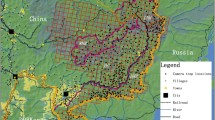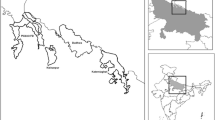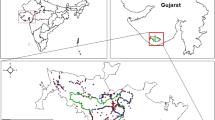Abstract
Bengal tiger and common leopard belong to endangered species in Nepal and elsewhere. They share their prey species, thus one affects prey availability of the other, which may contribute to decline in numbers of these carnivores. However, data on these interactions are very rare. We studied diet composition of tiger and leopard in Chitwan (Nepal), by analysing remnants of prey in scats of these two species and comparing abundance of prey species in scats with prey abundance recorded along line transects. We found that tiger prefers medium-sized (30–175 kg) prey, while leopard prefers small-sized (5–30 kg) prey, but also often eats medium-sized prey. Domestic animals (especially small ones) are more often eaten by leopard, compared with tiger. Consequently, these two predators compete mainly for medium-sized prey, but leopard relies more on small prey and domestic animals than tiger. We found that prey preferences of tiger and leopard also depend on the degree of habitat disturbance. Predators killed domestic animals in areas where there was a low density of wild prey. The conflict between humans and carnivores is the most important challenge threatening the conservation of carnivores, which depend on the abundance of different-sized prey and little human disturbance. Hence, restoring large populations of prey and reducing the level of human disturbance are the key measures necessary for the effective conservation of tiger and leopard.





Similar content being viewed by others
References
Ackerman BB, Lindzey FG, Hernker TP (1984) Cougar food habits in southern Utah. J Wildl Manag 48:147–155
Andheria AP, Karanth KU, Kumar NS (2007) Diet and prey files of three sympatric large carnivores in Bandipur Tiger Reserve, India. J Zool 273:169–175
Bhattarai BP, Kindlmann P (2012a) The impact of livestock grazing on wildlife habitat of Barandabhar Corridor Forest of lowland Nepal. In: Kindlmann P (ed) Himalayan biodiversity in the changing world. Springer, Dordrecht, pp 157–175
Bhattarai BP, Kindlmann P (2012b) Habitat heterogeneity as the key determinant of the abundance and habitat preference of prey species of tiger in the Chitwan National Park. Nepal Acta Theriol 57:89–97
Biswas S, Sankar K (2002) Prey abundance and food habits of tigers in Pench National Park, Madhya Pradesh, India. J Zool 256:411–420
Brodie JF (2009) Is research effort allocated efficiently for conservation? Felidae as a global study. Biodivers Conserv 18:2927–2939
Buckland ST, Anderson DR, Burnham KP, Laake JL, Borchers DL, Thomas L (2004) Introduction to distance sampling: estimating abundance of biological populations. Oxford University Press, Oxford
Chesson J (1978) Measuring preference in selective predation. Ecology 59:211–215
Dhungel SK, O’Gara BW (1991) Ecology of the hog deer in Royal Chitwan National Park Nepal. Wildl Monogr 119:1–40
DNPWC (2005) Annual report. Department of National Parks and Wildlife Conservation and Department of Forests, Kathmandu
DNPWC (2009) Tiger and their prey base abundance in terai arc landscape Nepal. Department of National Parks and Wildlife Conservation and Department of Forests, Kathmandu
DNPWC and PPP (2000) Royal Chitwan national park and buffer zone, resource profile. Babar Mahal, Kathmandu
Edgaonkar AJ, Chellam R (1998) A preliminary study on the ecology of the leopard, Panthera pardus fusca in the Sanjay Gandhi national park. Wildlife Institute of India, Dehradun
Floyd TJ, Mech LD, Jordan PJ (1978) Relating wolf scat contents to prey consumed. J Wildl Manag 42:528–532
Gurung B, Smith JLD, McDougal C, Karki JB, Barlow A (2008) Factors associated with human-killing tigers in Chitwan national park Nepal. Biol Conserv 141:3069–3078
Karanth KU, Stith BM (1999) Prey depletion as a critical determinant of tiger population viability. In: Seidensticker J, Christie S, Jackson P (eds) Riding the tiger: tiger conservation in human-dominated landscapes. Cambridge University Press, Cambridge, pp 100–113
Karanth KU, Sunquist ME (1992) Population structure, density and biomass of large herbivores in the tropical forests of Nagarahole, India. J Trop Ecol 8:21–35
Karanth KU, Sunquist ME (1995) Prey selection by tiger, leopard and dhole in tropical forest. J Anim Ecol 64:439–450
Koppikar BR, Sabins JH (1975) Identification of hairs of some Indian mammals. J Bombay Nat Hist Soc 73:5–20
Link WA, Karanth KU (1994) Correcting for overdispersion in tests of prey selectivity. Ecology 75:2456–2459
Manly BFJ, McDonald LL, Thomas DL, McDonald TL, Erickson WP (2002) Resource selection by animals: statistical design and analysis for field studies. Kluwer Academic Publishers, London
Mathur PK, Kumar H, Lehmkuhl JF, Tripathi A, Sawarkar VB, De R (2011) Mammal indicator species for protected areas and managed forests in a landscape conservation area of northern India. Biodivers Conserv 20:1–17
McDougal C (1977) The face of the tiger. Rivington Books, London
Miquelle DG, Smirnov EV, Merrill TW, Myslenkov AE, Quigley HB, Hornocker MG, Schleyer B (1999) Hierarchical spatial analysis of Amur tiger relationships to habitat and prey. In: Seidensticker J, Christie S, Jackson P (eds) Riding the tiger: tiger conservation in human dominated landscapes. Cambridge University Press, Cambridge, pp 71–99
Pianka ER (1974) Niche overlap and diffuse competition (desert lizards/resource partitioning/community structure/species diversity). Proc Natl Acad Sci USA 71:2141–2145
Primack RB (2008) A primer of conservation biology, 4th edn. Sinauer Associates, Sunderland
Sangay T, Vernes K (2008) Human–wildlife conflict in the Kingdom of Bhutan: patterns of livestock predation by large mammalian carnivores. Biol Conserv 141:1272–1282
Schaller GB (1967) The deer and the tiger. The University of Chicago Press, Chicago
Seidensticker J (1976) Ungulate populations in Chitwan valley, Nepal. Biol Conserv 10:183–210
Seidensticker J, Christie S, Jackson P (1999) Overview. In: Seidensticker J, Christie S, Jackson P (eds) Riding the tiger: tiger conservation in human-dominated landscapes. Cambridge University Press, Cambridge, pp 1–3
Sharma S, Jhala Y, Swarkar VB (2005) Identification of individual tigers (Panthera tigris) from their pugmarks. J Zool 267:9–18
Smith JLD, Wemmer C, Mishra HR (1987) A tiger geographic information system: the first step in global conservation strategy. In: Tilson RL, Seal US (eds) Tigers of the world: the biology, biopolitics, management and conservation of an endangered species. Noyes Publications, Park Ride, pp 464–474
Smith JLD, McDougal C, Miquelle D (1989) Communication in free-ranging tigers (Panthera tigris). Anim Behav 37:1–10
Smith JLD, McDougal C, Ahearn SC, Joshi A, Conforti K (1999) Metapopulation structure of tigers in Nepal. In: Seidensticker J, Christie S, Jackson P (eds) Riding the tiger: tiger conservation in human-dominated landscapes. Cambridge University Press, Cambridge, pp 176–189
Stoen OG, Wegge P (1996) Prey selection and prey removal by tiger (Panthera tigris) during the dry season in lowland Nepal. Mammalia 60:363–373
Sunquist ME (1981) The social organization of tigers (Panthera tigris) in Royal Chitwan national park. Smithson Contrib Zool 336:1–98
Sunquist M, Karanth KU, Sunquist F (1999) Ecology, behaviour and resilience of the tiger and its conservation needs. In: Seidensticker J, Christie S, Jackson P (eds) Riding the tiger: tiger conservation in human-dominated landscapes. Cambridge University Press, Cambridge, pp 1–3
Thomas L, Laake JL, Rexstad E, Strindberg S, Marques FFC, Buckland ST, Borchers DL, Anderson DR, Burnham KP, Burt ML, Hedley SL, Pollard JH, Bishop JRB, Marques TA (2009) Distance 6.0. Release 2. Research Unit for Wildlife Population Assessment, University of St. Andrews, Saint Andrews. http://www.ruwpa.st-and.ac.uk/distance/. Accessed 21 October 2009
Wang SW, Macdonald DW (2009a) Feeding habits and niche partitioning in a predator guild composed of tigers, leopards and dholes in a temperate ecosystem in central Bhutan. J Zool 277:275–283
Wang SW, Macdonald DW (2009b) The use of camera traps for estimating tiger and leopard populations in the high altitude mountains of Bhutan. Biol Conserv 142:606–613
Wegge P, Odden M, Pokharel CP, Storaas T (2009) Predator–prey relationships and responses of ungulates and their predators to the establishment of protected areas: a case study of tigers, leopards and their prey in Bardia national park, Nepal. Biol Conserv 142:189–202
Weins JA (1993) Fat times, lean times and competition among predators. Trends Ecol Evol 8:348–349
Wikramanayake ED, Dinerstein E, Robinson JG, Karanth KU, Rabinowitz AR, Olson D, Matthew T, Hedao P, Connor M, Hemley G, Bolze D (1998) An ecology-based method for defining priorities for large mammal conservation: the tigers as case study. Conserv Biol 12:865–878
Wikramanayake ED, Dinerstein E, Loucks C, Olson D, Morrison J, Lamoreux J, McKnight M, Hedao P (2001) Terrestrial ecoregion of the Indo-Pacific: a conservation assessment. Island Press, Washington, DC
Zar JH (1984) Biostatistical analysis. Prentice Hall, Englewood Cliffs
Acknowledgments
We wish to extend our thanks to the Department of National Parks and Wildlife Reserves for granting permission to do this study. We are indebted to Tony Dixon for careful language correction. We thank all the members and the volunteers from the Biological Society Nepal who helped in the field work: Manukala Bhattarai, Prakash Bhattarai, Tika Pariyar, Madan Dhungana, Shankar Shrestha and Homnath Marahatta. This research was supported by the grant LC06073 of the Czech Ministry of Education and by CzechGlobe—Centre for Global Climate Change Impacts Studies, Reg. No. CZ.1.05/1.1.00/02.0073 and also by the grants No. 06073 of the MSMT CR and No. 206/08/H044 of the GA CR.
Author information
Authors and Affiliations
Corresponding author
Rights and permissions
About this article
Cite this article
Bhattarai, B.P., Kindlmann, P. Interactions between Bengal tiger (Panthera tigris) and leopard (Panthera pardus): implications for their conservation. Biodivers Conserv 21, 2075–2094 (2012). https://doi.org/10.1007/s10531-012-0298-y
Received:
Accepted:
Published:
Issue Date:
DOI: https://doi.org/10.1007/s10531-012-0298-y




